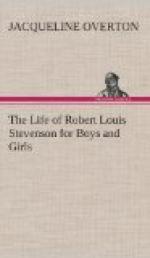In spite of all the obstacles, the work was completed at the end of two years and the light was shown for the first time February 1, 1811.
“I found Robert Stevenson an appreciative and intelligent companion,” writes Sir Walter Scott in his journal, speaking of a cruise he made among the islands of Scotland with a party of engineers. The notes made by him on this trip were used afterward in his two stories, “The Pirate” and “Lord of the Isles.”
“My grandfather was king in the service to his finger-tips,” wrote Louis Stevenson. “All should go his way, from the principal light-keeper’s coat to the assistant’s fender, from the gravel in the garden walks to the bad smell in the kitchen, or the oil spots on the storeroom floor. It might be thought there was nothing more calculated to awaken men’s resentment, and yet his rule was not more thorough than it was beneficent. His thought for the keepers was continual.... When a keeper was sick, he lent him his horse and sent him mutton and brandy from the ship.... They dwelt, many of them, in uninhabited isles or desert forelands, totally cut off from shops.
“No servant of the Northern Lights came to Edinburgh but he was entertained at Baxter Place. There at his own table my grandfather sat down delightedly with his broad-spoken, homespun officers.”
As he grew old his “medicine and delight” was his annual trip among his lighthouses, but at length there came a time when this joy was taken away from him and there came “the end of all his cruising; the knowledge that he had looked the last on Sunburgh, and the wild crags of Skye, and the Sound of Mull; that he was never again to hear the surf break in Clashcarnock; never again to see lighthouse after lighthouse (all younger than himself, and the more, part of his own device) open in the hour of dusk their flower of fire, or the topaz and ruby interchange on the summit of Bell Rock.”
Throughout the rank and file of his men he was adored. “I have spoken with many who knew him; I was his grandson, and their words may very well have been words of flattery; but there was one thing that could not be affected, and that was the look that came over their faces at the name of Robert Stevenson.”
Of his family of thirteen children, three of his sons became engineers. Thomas Stevenson, the father of Robert Louis, like the others of his family, contributed largely to lighthouse building and harbor improvement, serving under his older brother, Allen, in building the Skerryvore, one of the most famous deep-sea lights erected on a treacherous reef off the west coast where, for more than forty years, one wreck after another had occurred.
“From the navigator’s point of view, the danger of this spot lay chiefly in the fact that it was so widely scattered. The ridge runs like a broken backbone for a distance of some eight miles.... In rough weather the whole of the rocks are covered, and the waves, beating heavily on the mass, convert the scene into one of indescribable tumult....




